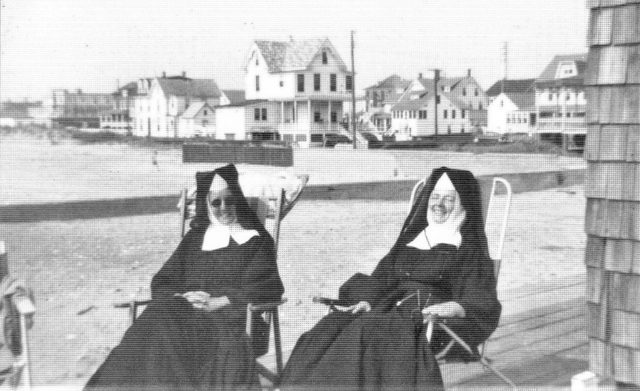
By BOB THIBAULT
They called them convents, retreat houses and religious vacation homes. Once, they could be seen up and down the beachfront in Sea Isle City, especially concentrated in the space of a dozen blocks south of downtown.
The Clergy were here to relax and to enjoy the city’s amenities – just like any other tourists. The religious orders represented reads like a litany: Sisters of Mercy of Philadelphia, Pittsburgh, and Maryland; Sisters of Saint Joseph, Saint Dominic, and The Holy Child; Daughters of the Redeemer; Augustinian Fathers; and Oblate Fathers of Washington, DC. There were more.
The architecture of these shorefront retreats displayed a smorgasbord of styles and sizes, from typical beach town homes to the latest in Victorian mansions. Over time, some changed names, some changed hands, some moved, some were damaged and restored, but most were eventually beaten to death by the wind and the sea. The buildings were all gone after the great nor’easter of March 1962.
Today, they make up a part of Sea Isle’s past heritage worth revisiting. The Sea Isle City Historical Museum has provided a collection of archived photographs which give a glimpse into this earlier landscape.
A “cottage” is usually pictured as a simple, single-level structure, accommodating just a few people. This wasn’t one of those. The humble Saint Rita of Cascio, Italy, for whom the cottage was named, would have thought it a grand palace.
The Augustinian Fathers used Saint Rita’s as a summer retreat. The men could be seen walking the beach in their traditional long black cassocks, reading their daily breviary. The masses they celebrated at the cottage were often attended by residents of the town.
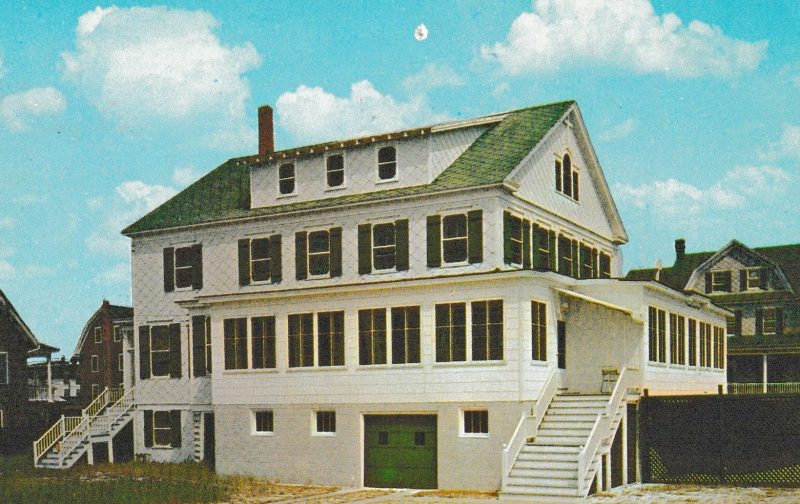
The story of the Pittsburgh Sisters in Sea Isle began in 1897 with the visit by one of the Sisters to her actual sister who was a Sister of Saint Joseph. Sister Mary Madeline O’Donnell liked it so much that she convinced her Pittsburgh hierarchy to rent a small, furnished cottage for the summer.
Things developed from there. Thanks to relatives of the Sisters, in 1900 they were able to build “St. Mary’s Sanitarium” on the corner of 48th Street and the boardwalk. It was modernized in 1927 and expanded to accommodate 36 occupants.
St. Mary’s naturally suffered through many storms. It was a way of life. The cottage was severely damaged by the hurricane of 1944, after which it was restored and improved. But then came March 6, 1962, when a tidal wave struck the cottage – and St. Mary’s was gone.
But the Sisters weren’t left without a cottage near the beach. Claude VanHook had established the Sea Isle Hospital and Training School in 1926 at the southwest corner of 48th Street and Pleasure Ave.
In 1958 it was sold to the Pittsburgh Sisters of Mercy to use as a vacation home which they called “St. Anne’s Cottage.” Forty years later, a fire all but totaled the home, and it was ultimately torched by a fire school for practice.
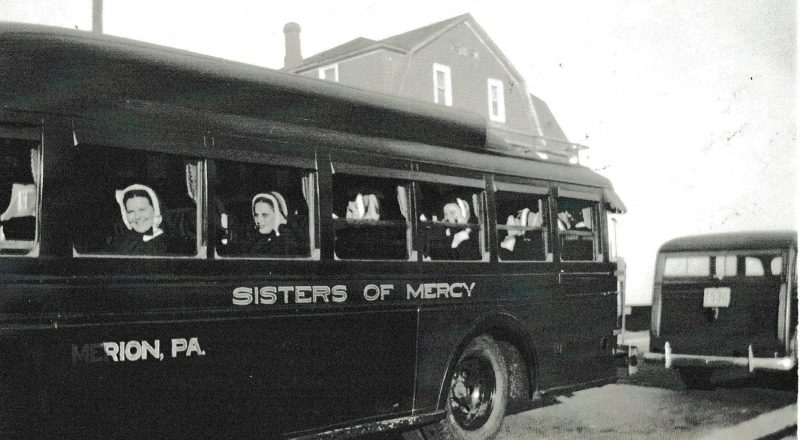
Just a block south of the Pittsburgh cottage, the Dominican Sisters of the Most Holy Rosary set up shop along the beach at the end of 49th Street.
In the 1920s the order had the temerity to charge seven dollars a week for a nun to stay at the convent during the summer. They thereby ran afoul of the tax man, who claimed this negated their tax-exempt status. So the Sisters decided to sue the City of Sea Isle City. They lost.
The Philadelphia Sisters’ involvement in the Sea Isle community peaked when they operated Mercy Hospital from 1953 to 1969 and taught at St. Joseph School from its opening in 1963.
But the Sisters had had a presence in the town long before that. From a material standpoint, their most outstanding achievement was the magnificent convent at 51st Street on the beach. This great gray Victorian mansion was built in the 1890s.
In 1915, the estate of William F. Rowan deeded property at 50th Street and the beachfront to the Baltimore Sisters of Mercy for a convent. The cost was $4,700, equivalent to $132,000 today – still a bargain.
The Sisters called their convent “Mercy Cliff,” although it was also known as “Half-Way House.” The names are a bit of a mystery. The original Mercy Cliff was enlarged and the upper floors remodeled in later years.
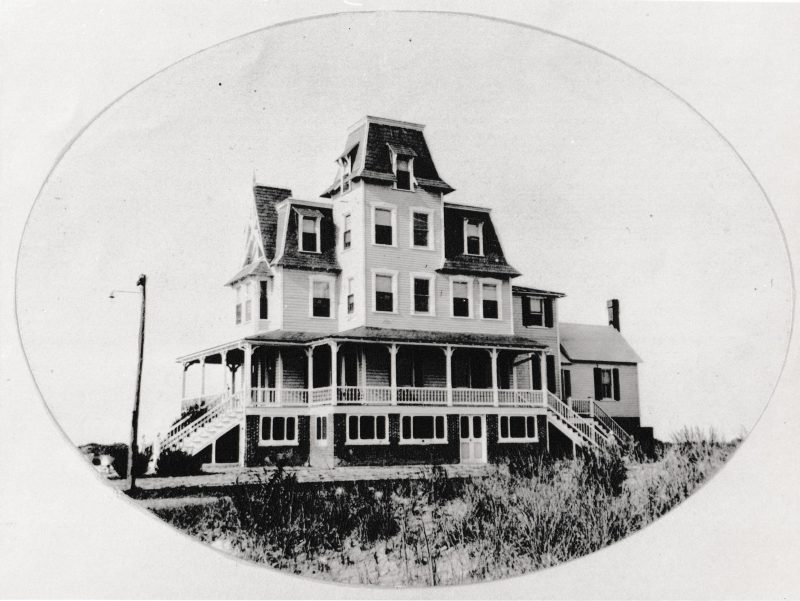
And there were others:
If we back off just a bit from the beach, more early religious buildings appear on the list. Two examples are the Mercy Hospital property and the Convent of the Sisters of the Holy Child. Surf Hospital, founded by Dr. Frank Dealy in 1946, was sold to the Sisters of Mercy in 1953, who renamed it “Mercy Hospital.”
When it was sadly closed in 1969, the Sisters turned it into a vacation home, and later replaced it with a three-building complex.
Today, it’s the site of the Saint Joseph By-the-Sea Retreat House, which fills the block between 58th and 59th Streets, just a block from the beach.
The Convent of the Holy Child was established at the northeast corner of 48th Street and Pleasure Avenue. The Sisters administered to the sick and homebound of St. Joseph’s parish. The building is still standing and still looks pretty much the way it looked in 1952.
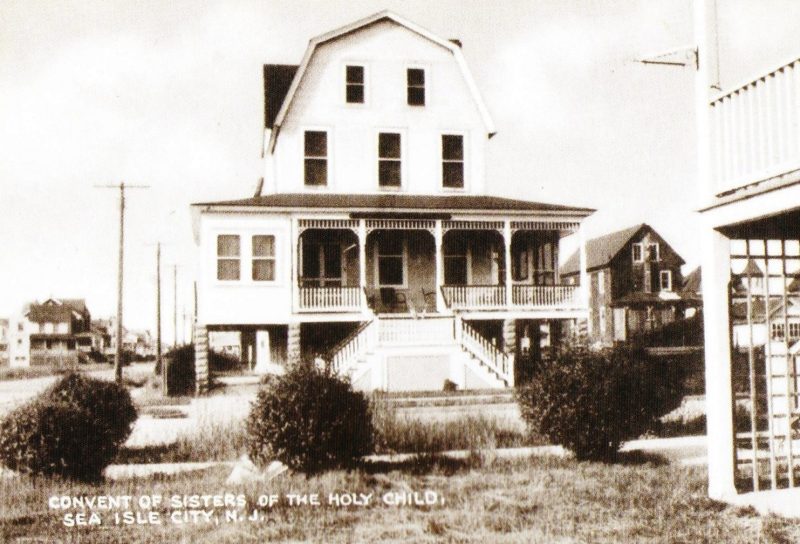
Beachfront Charities:
There was another category of ecumenical presence in the early days – that which provided a place at the shore for those who couldn’t afford it, especially children.
Examples were Camp Cardinal Dougherty between 26th and 27th Streets at the beach, St. Joseph’s Home for Boys at 13-53rd Street, and All Saints’ Sea Shore Home at 55th Street on the boardwalk.
Camp Cardinal Dougherty, which operated from about 1923 to 1940, was run by the Archdiocese of Philadelphia to give hundreds of inner city boys the opportunity to experience the fresh air of Sea Isle City in a self-governed, camp-like environment.
St. Joseph’s Home for Boys, built in 1900 and originally called “Gordon’s Seaview,” was also operated by the Philadelphia Archdiocese as a summer retreat for inner city boys. After it suffered a devastating fire in 2002, its rooftop cross was donated to the Sea Isle Museum and currently stands in the garden behind 4208 Landis Avenue.
In 1901, All Saints purchased the property once known as Prospect Hall and converted it into a charitable summer home. Its official name was “All Saints’ Sea-Shore Home for Women and Children.” It was operated by the Sisters of St. Clement’s Episcopal parish of Philadelphia.
All of the buildings written about in this article are gone now, save one. None that was standing at the beach on the day of the ’62 nor’easter managed to survive.
Some years later, Mother Mary Irenaeus Daugherty of the Pittsburgh Sisters of Mercy wrote in a letter to the Sea Isle Museum, “God again saw fit to show us who is Master of Sea and Earth, Wind and Waves.” Amen.
To enjoy a collection of photos, literature and artifacts, visit the Sea Isle City Historical Museum at 48th Street and Central Avenue (inside the Library).
Visit the website at www.seaislemuseum.com or call 609-263-2992. Current hours are 10 a.m. to 3 p.m. on Monday, Tuesday and Thursday, and 1 p.m. to 3 p.m. on Friday. Admission is free.
This “Spotlight on History” was written by Sea Isle City Historical Society Volunteer Bob Thibault. All images were provided by the Sea Isle City Historical Society.







